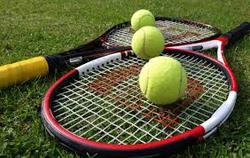lets play tennis!
 In a tennis tournament, each competitor plays against every other competitor, and there are no draws. Call a group of four tennis players “ordered” if there is a clear winner and a clear loser (i.e., one person who beat the other three, and one person who lost to the other three.) Find the smallest integer n for which any tennis tournament with n people has a group of four tennis players that is ordered.
In a tennis tournament, each competitor plays against every other competitor, and there are no draws. Call a group of four tennis players “ordered” if there is a clear winner and a clear loser (i.e., one person who beat the other three, and one person who lost to the other three.) Find the smallest integer n for which any tennis tournament with n people has a group of four tennis players that is ordered.
The answer is 8.
This section requires Javascript.
You are seeing this because something didn't load right. We suggest you, (a) try
refreshing the page, (b) enabling javascript if it is disabled on your browser and,
finally, (c)
loading the
non-javascript version of this page
. We're sorry about the hassle.
In a tournament with 8 people, since everyone plays against everyone else, there will be ( 2 8 ) = 2 8 games. Therefore, the total number of victories in the tournament is 2 8 . Therefore, the average number of victories per player is 8 2 8 = 3 . 5 . Therefore, by the Pigeonhole Principle, there must be a least one player who won at least 4 games. Let's call this player W , and we'll call the four losers A , B , C , D .
Now since there are 4 of them, the players A , B , C , D played ( 2 4 ) = 6 games amongst each other. Hence the average number of losses in this group is 4 6 = 1 . 5 . Therefore, by the Pigeonhole Principle, there is at least one player (let's say D ) who lost at least two games to other players in the group. Say D lost to A and B . Then the set W , A , B , D is ordered with the clear winner W and the clear loser D .
Therefore, any tournament of 8 people has an ordered group.
However we're not done yet; now let's show that not all tournaments of 7 players have an ordered group. Consider the following tournament with 7 players numbered 1 through 7 : ⎩ ⎪ ⎪ ⎪ ⎪ ⎪ ⎪ ⎪ ⎪ ⎨ ⎪ ⎪ ⎪ ⎪ ⎪ ⎪ ⎪ ⎪ ⎧ P l a y e r P l a y e r P l a y e r P l a y e r P l a y e r P l a y e r P l a y e r 1 2 3 4 5 6 7 b e a t s b e a t s b e a t s b e a t s b e a t s b e a t s b e a t s 2 , 3 , 4 3 , 5 , 7 4 , 5 , 6 2 , 6 , 7 1 , 4 , 7 1 , 2 , 5 1 , 3 , 6 Each of the players here beats 3 players and loses to 3 players. Notice that each of the above triplets creates a "triangle" in which each player wins exactly one game and loses exactly one game amongst each other. For example, in the first row we have 1 beats 2 , 3 and 4 , where 2 beats 3 , 3 beats 4 and 4 beats 2 .
Now in order to have an "ordered group", we must have one "clear winner" and one "clear loser". If there were a clear winner, however, then the three people that he/she won against would create a triangle and thus have no clear loser. Hence, this tournament has no ordered groups.
Therefore, the minimum is 8 .